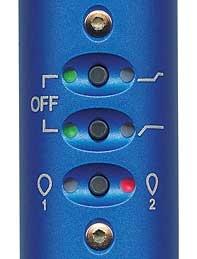Products
| Audio Ltd. | CEDAR Audio Ltd. | HHB Communications Ltd. | Sadie Studio Audio & Video Ltd. |
| Schoeps GmbH | Sonosax S.A. | Salient Sciences | Pinguin |

Shotgun microphone SuperCMIT
- new type of digital shotgun microphone with increased directivity, based on SCHOEPS' extremely successful analog model CMIT 5
- diffuse sound is suppressed to an extraordinary degree
- completely new operating principle with two transducers
- uses digital signal processing algorithms from ILLUSONIC (patent pending)
- two-channel output, with SuperCMIT signal in channel 1 and (direct, single-transducer) CMIT signal in channel 2
- SCHOEPS sound quality: transparent sound

The SuperCMIT defines a new category of shotgun microphone, with directivity that goes beyond anything previously known. It offers the recording engineer entirely new possibilities.
Where would I use the SuperCMIT?
The SuperCMIT can be a problem-solver wherever diffuse sources of noise (such as street noise, wind noise, room sound, or audience and passers-by) might interfere with a recording. Unwanted noise is greatly reduced in level – even at low frequencies – without altering the tone color of front-arriving direct sound. Even a shotgun with a long tube can’t do that. This makes the SuperCMIT ideal for complex film sound applications and for sports events. The SuperCMIT also increases the “reach” of indoor recordings.
How does the SuperCMIT achieve this directivity?
Digital signal processing in the SuperCMIT recognizes sound energy arriving from various directions, and determines whether that sound has a discrete, persistent direction of arrival or not. It uses this information to suppress diffuse sound and to focus on discrete sound. This allows the “reach” of the shotgun microphone to be increased significantly, without causing the usual sound-coloring artifacts. The SuperCMIT is the first microphone in the world to combine such high directivity with high sound quality.

– High-frequency boost (+5 dB at 10 kHz) compensates for losses due to windscreens.
– Steep low-cut (18 dB/oct. below 80 Hz) suppresses low-frequency wind and boom noise.
The second output channel always carries the signal of the regular shotgun. The “Preset” button controls the directivity for the signal on the first output channel (SuperCMIT). Two settings are available:
– Preset 1: moderate directivity increase (green LED); ca. 11 dB reduction in diffuse sound (5 dB greater than a Schoeps CMIT or channel 2 of the SuperCMIT)
– Preset 2: strong directivity increase (red LED); ca. 15 dB diffuse sound reduction. This setting is reserved for special applications since sonic artifacts can occasionally be heard.
– By pressing each of the three pushbuttons two times each quickly in succession, the gain can be increased by +30 dB and reset again to the standard value.
Also by disconnecting the microphone from its power supply, the gain setting is reset to the initial value (0 dB).
Since firmware version 2.0 the SuperCMIT is equipped with a limiter (when gain boost is active) to prevent overload caused by very loud signals.

Included accessories:
Wooden case, SG 20 stand adapter, W 170 foam windscreen for moderate wind and boom motion.
Available separately:
Mini-DA42: device for powering digital microphones; with digital and analog outputs
PSD 2U powering box for 10-Volt digital phantom powering (DPP) with XLR and RCA outputs; AC adapter included;
Softie-Mount: shock mount with pistol grip;
WSR CMIT windscreen with “Windjammer” covering (for stronger wind)
A new approach to high directivity and sound quality

The SuperCMIT microphone uses exclusive technology from ILLUSONIC (patent pending). In addition to the capsule behind the interference tube, it contains a second, rear-facing microphone capsule. Digital signal processing (DSP) can analyze both signals and thereby distinguish discrete versus diffuse sound energy. The two signals are then combined in a time- and frequency-dependent manner such that the directional effect for discrete sound energy is increased while the level of diffuse sound is reduced.
At high frequencies (above 6 kHz) only the signal from the front-facing capsule is used, since the interference tube already offers optimal effectiveness in that range.





























